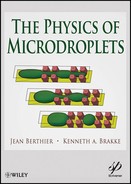Preface
Capillary phenomena are intriguing. During the many years I (Jean) have spent with my colleagues working on microsystems for biotechnology, I have observed the difficulty to predict – and sometimes understand – the behavior of droplets and interfaces at the micro scale. First, optical observation is not straightforward – it is not easy to locate an interface seen from above in the microscope. Second, the analysis of the observed phenomena is complicated. In my personal experience, that was the case for pancreatic cells encapsulation in micro-flow-focusing devices, liquid-liquid extraction systems, digital microfluidics, capillary valves, spontaneous capillary flows in closed and open channels, in cracks, and between fibers.
And the difficulty is even more important for the conception of new microsystems. Questions such as “where is the interface going to anchor?” or “will the particles cross the interface?” or “will the interface de-pin when the capsule arrives?” or “will the capillary force be sufficient?” are repeatedly being asked. Although illustrious pioneers such as P-G. de Gennes, D. Quéré, G.M. Whitesides, and others have contributed to the knowledge of interface behaviors on a theoretical standpoint, much is left to understand for the engineer having to design a microchip or the student behind his computer or the biologist at his lab bench.
In this book, Ken and I have attempted to give the reader the tools for solving these capillary and surface tension problems, present theoretical tools derived from previous works of colleagues and our personal experience, as well as provide calculation tools through the Surface Evolver numerical program.
I first heard about Evolver at a Nanotech Conference in 2004 and its potential for two-phase microflows and droplets behavior. Although it cannot treat the dynamics of a flow, it can be used to predict the stable shape and location of droplets and interfaces. A typical example is that of a capillary valve where the bulging out of the interface directly depends on the applied pressure. Besides, useful information can be gained by considering that an interface or a droplet has not reached its equilibrium position: this is for example the case of spontaneous capillary flows or droplets moving up a step or a slope. Finally, at the microscale, interfaces are restored nearly immediately by capillary and surface tension forces, which frequently dominate the other forces like weight, viscosity, and inertia. This applies for example to self-alignment problems.
I started to work with Evolver for predicting the behavior of droplets in digital microfluidic systems. Because the electrowetting effect can often be translated into a capillary effect (capillary equivalence), Evolver is well suited to treat such problems. I had the fortune that the author of Surface Evolver, Kenneth Brakke, agreed to assist me with the handling of the numerical program and our cooperation was extremely fruitful. After a few years of working on this topic, as well on the theoretical, numerical and experimental aspects, I had the opportunity to write the book Microdrops and Digital Microfluidics in 2008.
But many capillary problems were still to be tackled outside the domain of digital microfluidics. I continued to use Evolver, again with Ken’s help. When our Evolver tool box was sufficient, we thought that it could be useful to make it available to the scientific community and decided to write this new book with my publisher Martin Scrivener. The Evolver files corresponding to the examples and problems of this book are available for the reader at the internet address http://www.susqu.edu/brakke/physicsofmicrodrops.
We hope that our work will be useful to boost the developments of microfluidic systems and that this book will find an echo in the micro and nanotechnology world.
Jean Berthier, Grenoble, February 22, 2012
Kenneth A. Brakke, Susquehana University, February 22, 2012
